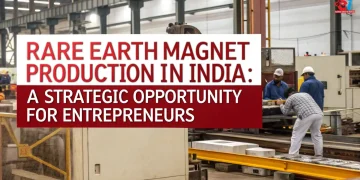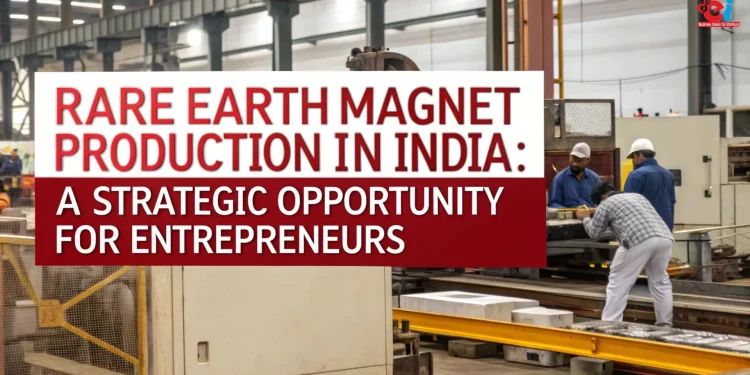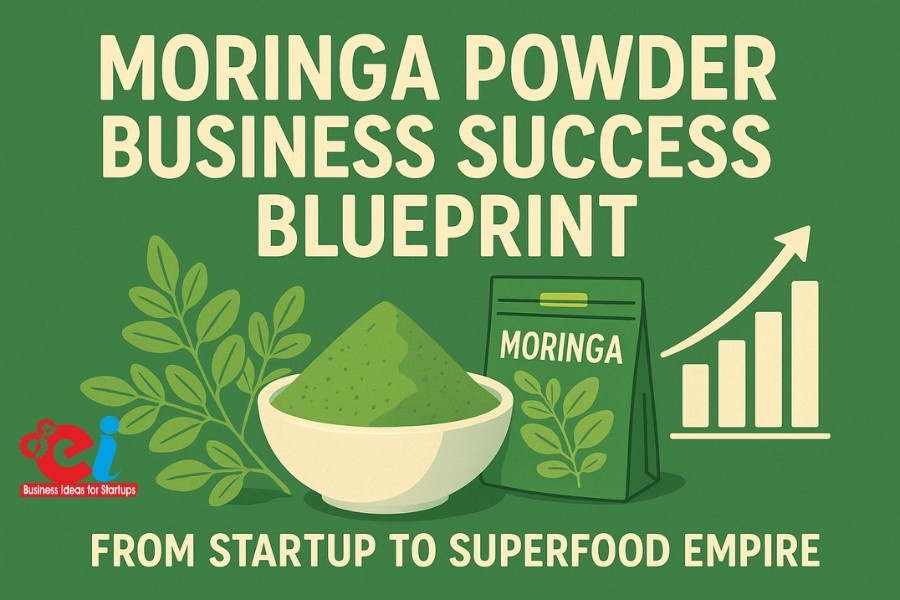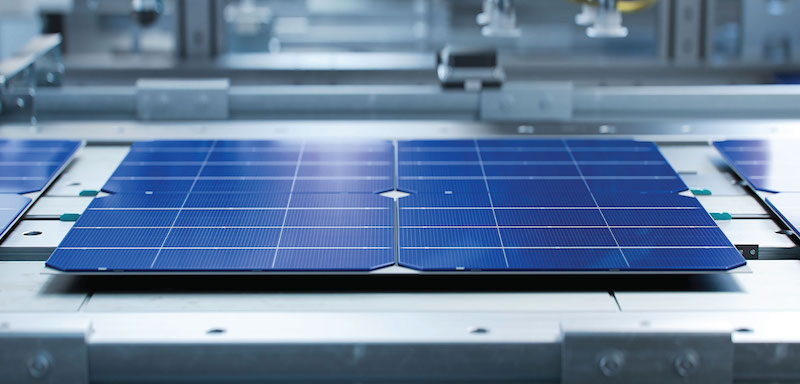The Indian rare earth magnet manufacturing industry is on the verge of a life-changing shift, offering unique new prospects for job creators willing to step into this strategically important sector. Thanks to the bold steps of the Indian government focused on reducing import reliance and fostering in-country manufacturing, the rare earth magnet industry has emerged as one of the foremost sectors, receiving government attention with substantial support through Production Linked Incentive (PLI) schemes.
The importance of rare earth magnets goes much beyond their characteristics. As recently confessed by Union Coal and Mines minister G Kishan Reddy, magnets are essential to modern technologies such as smartphones, electric motors, electric vehicles, wind energy converters, and defense systems. They not only enhance technological advancements but also bolster economic strength, as complete dependence on imports will be lifted with the government’s new policies aimed at manufacturing self-sufficiency. The grants provided under PLI are meant to be a catalyst for these developments.
In this blog, we will analyze India’s production of rare earth magnets along with other relevant topics such as the industry’s growth potential, government policies, investment opportunities, and the most important: the entrepreneurial prospects.
Analyzing the Market and Opportunities for Growth
Overview of Current Numbers and Future Outlook
The data available on Indian rare earth magnets indicates that it has a huge potential in terms of business opportunities. As per available industry research, the India rare earth magnet market size was around USD 637.4 million in 2024 and is forecasted to grow to USD 993.0 million by 2033, marking a compound annual growth rate (CAGR) of 5.1% for the period between 2025 and 2033.
Additionally, the rest of the rare earth elements market in India earned revenue of USD 40.7 million in 2024 and is projected to increase by 53% to reach USD 62.9 million by 2030, presenting strong growth around an 8.1% CAGR from 2025 to 2030. The neodymium market, which includes permanent magnets, is expected to see significant growth as well. Neodymium, which is used in high-performance permanent magnets, was noted as the strongest performing segment in 2024. The neodymium market in India is estimated to reach USD 99.5 million by 2030, demonstrating a very strong 15% CAGR.
An overview of the global rare earth magnet market further illustrates the scope of growth India could achieve. It was valued at USD 19.1 billion in 2023, and is expected to grow to USD 30 billion by 2030, expanding at a CAGR of 6.7% between 2024 and 2030. Such growth opens avenues for Indian industries not only to cater to domestic consumption but also to compete globally.
Several key industries that are undergoing rapid advancement and growth fuel the demand for rare earth magnets in India. The automotive industry, particularly with regards to electric vehicles, stands as the largest and the most rapidly growing area of application. India’s commitment towards electric mobility along with Governmental efforts to boost EV sales will create an unprecedented demand for high-performance permanent magnets used in electric motors.
Another major demand contributor would be the electronics and telecommunication sector. Rare earth magnets have a significant position in the value chain of smartphones, tablets, laptops, speakers and other consumer electronics. With the continuous growth of the electronics manufacturing sector under the Make in India initiative, there will be a commensurate domestic need for these magnets.
The renewable energy sector is growing rapidly, and wind power generation is at the forefront of this expansion. Turbines made us of wind generators necessitate rare earth magnets which India has plans to use.
There are also additional market opportunities in defense and aerospace as rare earth magnets are essential elements to radar systems, military equipment, guidance systems, and other parts. Focusing on defense manufacturing strengthens demand under the Atmanirbhar Bharat initiative.
Related: Building a Rare Earth Metals Business: Key Insights
Government Support and Policy Framework
Production Linked Incentive (PLI) Schemes
The Indian government is willing to spend large amounts of money on rare earth magnet production with incentives such as PLI. These Production Linked Incentive schemes offer financial payout based on the amount produced, which is beneficial for new entrepreneurs entering the sector.
The estimated government allocation for these further incentives is Rs 1,345 crore to Rs 5,000 crore. These schemes will allow manufacturers to receive a grant proportionate to the volume of production and so be provided with financial support for increasing production.
The incentive structure aims to mitigate the challenges posed by the initial capital investment and ongoing operational costs of setting up rare earth magnet manufacturing facilities. Such government support decreases financial risks for businesses and actually helps secure a competitive edge during the critical periods of early growth.
National Critical Mineral Mission (NCMM)
The Union Cabinet authorized the launch of the National Critical Mineral Mission with the proposed expenditure of 16,300 crores along with a prospective investment of 18,000 crores by Public Sector Undertakings in January 2025. This mission outlines an integrated approach towards the development of strategic minerals of India including the rare earth elements required for magnets.
As part of the NCMM, entrepreneurs have access to government-sponsored research and development facilities, offered technology transfer schemes, and organized assistance in raw material supplies. This program enables private manufacturers to gain the critical technical know-how and infrastructure required for the efficient production of rare earth magnets.
Technology Transfer and Infrastructure Support
The government goes beyond providing financial assistance by also offering technology transfer as well as infrastructure development. A permanent magnet processing unit with advanced machinery and technology has been constructed by the Non-Ferrous Materials Technology Development Centre (NFTDC) in Hyderabad, which is supported by the Ministry of Mining.
As mentioned by Minister G Kishan Reddy, the government intends to provide private manufacturing firms with the technology created by NFTDC. This technology transfer mechanism enables entrepreneurs to obtain established methods of production and equipment schedules, greatly minimizing the technical hurdles to innovation and the timelines needed for progress.
Manufacturing Process Overview
Sourcing and Raw Material Requirements
The process of manufacturing rare earth magnets begins with obtaining and preparing raw materials. The primary components needed are neodymium, iron, boron, and some other rare earths depending on the type of magnet. Although the reserves of rare earth elements in India are meager, the government did formulate a strategy of importing raw materials to process them and provide value addition through domestic production.
Most neodymium magnets are based on the compound Nd2Fe14B which needs neodymium, iron, and boron in the precise ratios of neodymium 30%, iron 65%, and boron 1% with traces of other elements like dysprosium or terbium to improve certain characteristics. The quality and purity of the supplied raw materials impact the final magnet performance and the yield in manufacturing, embedding affectionately these factors is critical.
Step-by-Step Manufacturing Process
Each step of the production process for rare earth magnets is very delicate and demands precision and great skill:
Melting and Alloying
To achieve bonds with desired magnetic properties, raw materials are separated into components, which are then melted in high-temperature furnaces using vacuum induction melting techniques. This process creates a homogeneous alloy. The melting temperature usually ranges from 1,100°C to 1,200°C. Ideally, the melting process should create a controlled atmosphere, which would help in avoiding oxidation.
Milling and Powder Production
Solidified alloys can now be milled and crushed using specialized jet or ball milling machines. Achieving the desired level of particle size such as 3-7 micrometers, is essential. Additionally, milling also requires that it be done under inert atmospheres so that RARE MATTERS such as rare earth elements do not oxidize.
Pressing and Alignment
Use of hydraulic presses helps in compressing powders into shapes while simultaneously enhancing alignment of magnetic domains. This is essential in ensuring strong magnetic performance of the final product.
Sintering and Heat Treatment
The pressed powder compacts undergo sintering in high-temperature furnaces at temperatures ranging from 1000°C to 1100°C. These two steps are essential in consolidating the material, achieving the final microstructure and optimizing its unique magnetic features. Additional steps in heat treatment can be coupled to further enhance the material’s properties.
Machining and Shaping
The shaped sintered magnets undergo further machining processes to attain the desired final size and shape. The use of diamond-coated cutting tools and specific machines make these processes both effective and efficient. Working with rare earth magnets demands precision tools due to their brittle composition.
Coating and Surface Treatment
Magnets are coated to prevent corrosion, using materials like nickel, zinc, and epoxy. Transparent antifouling coatings serve to increase durability while providing protection from external factors. These measures help in ensuring reliability and functional longevity in different settings.
Magnetization
Processed magnets are magnetized with powerful electromagnets, unlocking their full magnetic potential. This magnetization must be done by specialized equipment designed to produce several Tesla of the magnetic field, ensuring strength during the process.
Related: How to Profit from Rare Earth Alloys
Quality Control and Testing
During manufacturing, products undergo several quality checks to ensure they meet standards through the processes of checking their magnets, measuring their dimensions, measuring the coating thickness and checking for corrosion. Quality control describes the entire system for assuring the quality of manufactured products. Implementing these systems is important for compliance in the market as well as customer satisfaction.
Investment Requirements and Financial Considerations
Capital Investment Analysis
Opening a facility that manufactures rare earth magnets involves significant capital investment in many different areas. The initial investments include buying land, building the infrastructure, purchasing the necessary equipment and machinery, and working capital for operations and raw materials.
For a medium scale rare earth magnet manufacturing plant with an annual production capacity of 100 to 500 tons, the estimated capital investment ranges between Rs 50 crore to Rs 200 crore. This is dependent on the level of automation, production capacity, and the specifics of the products to be manufactured. The investment amount includes vital pieces of equipment such as melting furnaces, milling machines, pressing equipment, sintering furnaces, machining tools, and coating facilities.
Machinery and equipment costs are the largest portions of the capital investment, usually 60-70% of the total cost of the project. High temperature furnaces and specialized high end milling and precision machining tools are crucial, albeit very costly, for the production of quality items.
Operating Costs and Raw Material Expenses
Other operating costs of rare earth magnet manufacturing contain the procurement of raw materials, energy usage, workforce expenses, maintenance expenses, and administrative overheads. Raw materials make up 40-50% of the production cost making it imperative to manage raw material sourcing efficiently.
Energy costs also affect spending, as electricity is needed for melting, sintering, and machining in the manufacturing process. The energy needed for such processes is estimated to be between 15-25 kWh for every kilogram of magnet finished, depending on the efficiency and production method used.
Financial Backed Aid and Funding Strategies
Different sources of funding are available for entrepreneurs looking to invest in the manufacturing of rare earth metals. Government PLI schemes are available and assist by offering direct financial incentives that reduce the initial investment cost. Also available are bank sector lending, industrial development lending, and venture capital financing focused on technology manufacturing.
Opportunities for Public Private Partnerships (PPP) or Joint Venture (JV) collaborations with government institutions and public sector undertakings are facilitated by the Government’s commitment to the sector through NCMM and other initiatives.
Market Entry Approaches And Business Gaps
Target Buyer Segments
Identifying and thoughtfully targeting key customer segments are essential for successful market entry. The fastest growing and most valuable segment is the automotive industry and electric vehicle manufacturers. Early adopters include Mahindra and Uno Minda, who are already interested in domestic sourcing and showcase market readiness.
Another major customer base is electronics manufacturers, including smartphone assembly companies, consumer electronics producers, and component manufacturers. The Government’s Production Linked Incentive schemes for electronics manufacturing creates additional opportunities for locally manufactured magnets.
The industrial equipment sector, such as motor, generator, and automation equipment manufacturers, also has a steady need for specific grades and types of magnets. This segment often requires bespoke solutions and long-term partnerships.
Competitive Advantages and Market Positioning
Domestic suppliers have several advantages over imports, such as shorter lead times, lower shipping costs, favorable exchange rates, and improved after sales service. The increased focus on supply chain security and reduced reliance on imports greatly benefits local suppliers.
Domestic manufacturers can use quality certifications and technical support as differentiators from commodity suppliers. Partnering with research institutions and technology providers improves innovation and market credibility.
Strategic Partnerships and Collaborations
Establishing strategic partnerships with key players in upstream segments can offer access to new markets and invaluable industry knowledge. Collaborations with these entities can also expand the development and adoption of technology into targeted markets.
NIIR Project Consultancy Services (NPCS) is pivotal in assisting entrepreneurs by preparing complete Market Survey cum Detailed Techno Economic Feasibility Reports for rare earth magnet manufacturing projects. These reports cover the examination of the processes involved in manufacturing, the required raw materials, the design of the plant, and the detailed financial estimates. NPCS systematically analyzes the viability of establishing new industries or businesses in the rare earth magnets industry, thus aiding the decision making process.
Challenges and Risk Mitigation
Technical and Operational Challenges
There are several technical challenges associated with rare earth magnet manufacturing that an entrepreneur would need to resolve. The rare earth elements need to be handled very carefully due to their health risks and therefore require specialized knowledge and safety measures. The maintenance of quality in production batches needs to be uniform which for most cases requires sophisticated automation and skilled technicians to manage the process.
The accuracy of the techniques used means that precision engineering tools must be employed and the machines need to be properly maintained. Environmental responsibility and waste management are of primary importance because the manufacturing processes create toxic waste that must be treated.
Risks of Supply Chains and Raw Materials
Using imported materials puts the company at risk for supply chain interruptions and fluctuating costs. Developing diversified sourcing strategies while maintaining optimal stock levels can counter these risks. Having long-term contracts and strategic alliances with suppliers ensures more stability.
These risks will be gradually reduced as the government works towards developing local rare earth resource mining and processing, but entrepreneurs need to account for changeover phases and supply chain interruptions.
Step-by-Step Manufacturing Process
There are some important parts to the manufacturing process in the production of rare earth magnets. Each part requires different specialized equipment to get the required technical needs:
Melting and Alloying
The required elements are combined and put in an induction furnace to be melted. During this stage, it is very important that the materials are kept under vacuum conditions to prevent oxidation, and the temperature is kept between 1100 and 1200 degrees Celsius. Only after reaching optimal conditions will a homogeneous alloy be produced.
Milling and Powder Production
Such fused alloys are then put into specialized jet or ball mills for them to be crushed and milled. Using such equipment helps in achieving the required particle size distribution of 3 to 7 micrometers. Just as in the previous stage, the milling needs to be done in inert atmospheres to prevent oxidation.
Pressing and Alignment
To compact magnetically, the powder is set into dies and pressed using hydraulic presses. In addition to using electricity, these processes also help in structurally controlling the final product’s magnetic domains which strengthens its performance.
Sintering and Heat Treatment
After compacting the powders, they are placed into high temperature furnaces where the temperature ranges between 1,000°C and 1,100°C. During this process, the material is densified and the final microstructure is formed. Some additional heat treatment processes may be necessary to further enhance the magnetic characteristics.
Machining and Shaping
Using specialized machinery, the sintered magnets are cut to their final dimensions. This is done using diamond-coated cutting tools. Rare earth magnets are brittle, so this step demands precise equipment.
Coating and Surface Treatment
To increase the structural integrity and prevent further damage to the surface of the magnets, nickel, zinc or epoxy coatings can be added to the surface. This is important to make certain that the magnets perform well in different conditions over a long period of time.
Magnetization
At this stage, the processed magnets are subjected to strong electromagnets so that their full magnetic potential is reached. During this step, unique equipment that is capable of generating several Tesla magnetic fields is needed.
Quality Control and Testing
Throughout the manufacturing process consistency is key and implementing control measures is essential to maintain quality product. Evaluation of magnetic properties and dimensions, thickness of coating, and evaluating resistance to corrosion are some of the tests performed. These quality control systems are crucial for meeting industrial demands and customer needs.
Investment Requirements
Evaluating Capital Investment
The establishment of a plant for the production of rare earth magnets is associated with major capital expenditures in different categories. Initial capital expenditures included land purchasing, construction of the building, acquisition of machines, and operational working capital for raw materials as well as day-to-day activities.
For a medium scale rare earth magnet manufacturing plant with an annual capacity of 100–500 tons, capital investment is projected to lie within Rs 50 crore – Rs 200 crore based on the level of automation, production capacity, and product specifications. This investment encompasses key equipment such as melting furnaces, moths, pressing equipment, sintering furnaces, machining tools, and coating facilities.
The machinery and equipment segment of the investment represents the largest component of capital investment, often 60 to 70 percent of the total project value, which pose as high value machinery and equipment such as high-temperature Treibmellen, special precision mice and other tools critical for production efficiency.
Variations in Operating Costs and Expenses Associated with Essential Materials
The operating costs in manufacturing of rare earth magnets includes expenses which are procurement of raw materials, purchase of energy, employees salaries and wages, maintenance costs, and general administration costs. Sourcing raw materials for production impacts approximately 40 to 50 percent of production costs, making these services highly critical in ensuring value for money.
Furthermore, energy expenses contribute heavily, as the manufacturing requires large amounts of electricity used for melting, sintering, and machining. The energy necessary for each operation averages between 15–25 kWh for each magnet produced based on the level of efficiency used within the respective operation.
Different Options For Financial Support and Funding
With the introduction of rare earth magnet manufacturing projects, different sources of funding become available. Direct financial incentives available under government PLI schemes can cover a sizeable portion of the investment cost required in undertaking financial structure projects. Moreover, direct sector lending from other financial institutions, loans for industrial development, and investment capital are also available for tech oriented manufacturing projects.
Opportunities for public-private partnerships or joint ventures for government funded entities are also available owing to the government’s focus on the sector through NCMM and other initiatives.
Available Business Opportunities and Strategies for Market Entry
Identification of Prospective Customers
Identifying and targeting key customer segments for the respective market is critical to ensuring successful entry within the market. The automotive market, and in particular, electric vehicle manufacturers, is the most attractive and fastest growing segment. Domestic suppliers such as Mahindra and Uno Minda have shown interest and therefore, the receptivity in the market is high.
Another important customer group includes electronics assemblers, smartphone makers, consumer electronic manufacturers, and parts producers. Magnets for electronics manufacturing also need to be supplied due to government incentives under the Production Linked Incentive policies.
Industries such as generators, motors, and automation equipment also serve as an important continuous customer base for specific grades of magnets as they have consistent demand. This customer group tends to buy bespoke items and require long-term contracts.
Competitive Advantages and Market Positioning
Domestic competitors have a notable edge over foreign competitors because of shorter shipping times and costs, stable currency, and better customer relations. Foreign competitors lose attractiveness with government policies focused on supply chain control and self-sufficiency.
Domestic manufacturers can use quality marks, technical assistance, and tailored products to stand out from generic providers. Commodity relations with these businesses increase their trustworthiness and inventive capacity when paired with good research and tech partners.
Strategic Partnerships and Collaborations
Access to the market and know-how from downstream collaborators can be obtained through strategic partnerships. Those in the market and the foreign collaborators can speed up the use of technology in the market with research institutions, and tech suppliers.
NPCS (NIIR Project Consultancy Services) is instrumental in helping entrepreneurs by providing extensive Market Survey cum Detailed Techno Economic Feasibility Reports for the manufacturing of rare earth magnets. These reports cover an in-depth analysis of the processes involved in manufacturing, the materials needed, the layout of the plant, and even the detailed financial forecasts for the project. NPCS guides entrepreneurs in systematically evaluating the viability of establishing new projects or industries in the rare earth magnet space, offering invaluable support for informed decisions.
For more information, watch this video
Challenges and Risk Mitigation
Technical and Operational Challenges
Starting and running a business in the field of rare earth magnet manufacturing comes with a lot of technical and operational challenges and risks that need to be dealt with. This is because rare earth elements require special techniques because of their chemical nature and the potential hazards they pose to health. In order to achieve production batch quality control consistency, sophisticated systems as well as skilled personnel are needed within the production processes.
Along with these challenges comes the precision needed for the manufacturing processes which means that the equipment must fully meet high standards and should have a well-defined maintenance schedule. On top of all of this, the company has to focus on environmental compliance waste management resulting from the manufacturing process which generates hazardous wastes that need to be treated and properly disposed of.
Supply Chain and Risks Incurred from Raw Materials
Reliance on foreign countries for the procurement of raw materials results in increased risks regarding supply chains as well as price fluctuations. Supply chain vulnerabilities are alleviated by implementing diversified sourcing strategies or maintaining optimal levels of inventory. Forming long-term supply agreements along with strategic partnerships gives businesses protection against risks.
These risks are likely to decrease over time as the government works towards developing domestic rare earth mining and processing. However, during these transition periods, entrepreneurs need to anticipate disruptions in the supply chain.


























